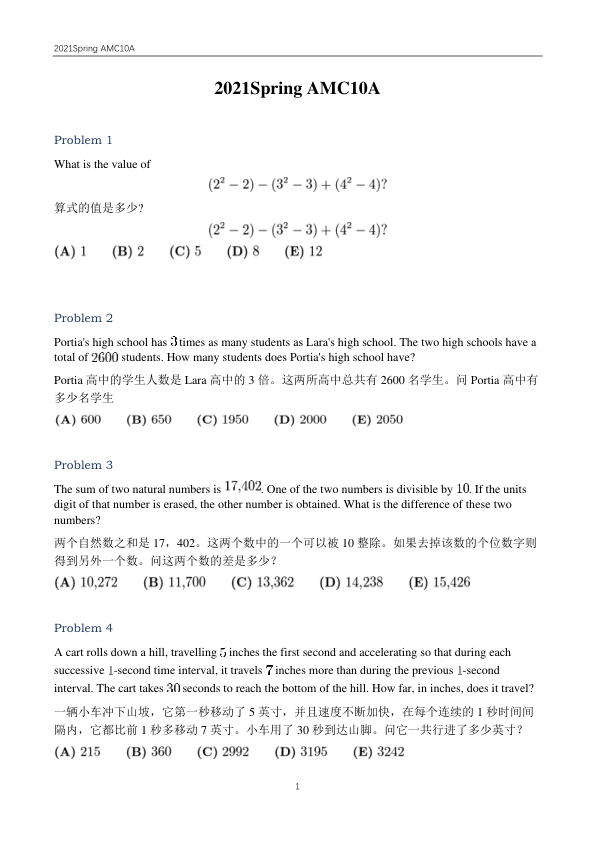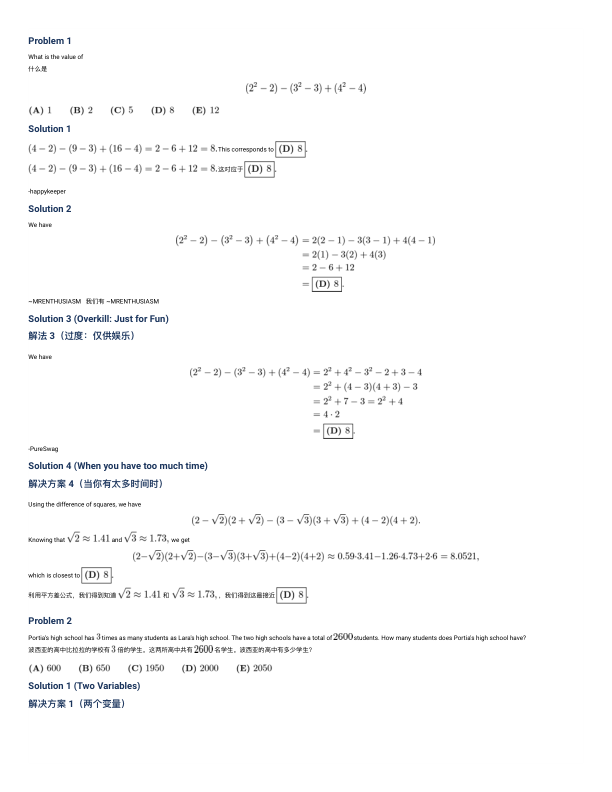2021 AMC amc10a 真题 答案 详解
| 序号 | 文件列表 | 说明 | ||
|---|---|---|---|---|
| 1 | 2021-amc10a-paper-eng-zh.pdf | 12 页 | 446.59KB | 中英双语真题 |
| 2 | 2021-amc10a-paper-eng.pdf | 4 页 | 223.57KB | 英文真题 |
| 3 | 2021-amc10a-key.pdf | 1 页 | 9.93KB | 真题答案 |
| 4 | 2021-amc10a-solution-eng.pdf | 37 页 | 3.24MB | 真题文字详解(英文) |
| 5 | 2021-amc10a-solution-eng-zh.pdf | 54 页 | 3.60MB | 真题文字详解(中英双语) |
| 6 | 2021-amc10a-solution-video-zh.mp4 | 102.47 分钟 | 253.68MB | 真题视频详解(普通话) |
中英双语真题
2021Spring AMC10A
Problem 1 What is the value of $(2^2-2)-(3^2-3)+(4^2-4)?$
算式的值是多少?
$(2^2-2)-(3^2-3)+(4^2-4)?$
(A) 1 (B) 2 (C) 5 (D) 8 (E) 12
Problem 2 Portia's high school has 3 times as many students as Lara's high school. The two high schools have a total of 2600 students. How many students does Portia's high school have?
Portia 高中的学生人数是 Lara 高中的 3 倍。这两所高中总共有 2600 名学生。问 Portia 高中有多少名学生
(A) 600 (B) 650 (C) 1950 (D) 2000 (E) 2050
Problem 3 The sum of two natural numbers is 17,402. One of the two numbers is divisible by 10. If the units digit of that number is erased, the other number is obtained. What is the difference of these two numbers?
两个自然数之和是 17,402。这两个数中的一个可以被 10 整除。如果去掉该数的个位数字则得到另外一个数。问这两个数的差是多少?
(A) 10,272 (B) 11,700 (C) 13,362 (D) 14,238 (E) 15,426
Problem 4 A cart rolls down a hill, traveling 5 inches the first second and accelerating so that during each successive 1-second time interval, it travels 7 inches more than during the previous 1-second interval. The cart takes 30 seconds to reach the bottom of the hill. How far, in inches, does it travel?
一辆小车冲下山坡,它第一秒移动了 5 英寸,并且速度不断加快,在每个连续的 1 秒时间间隔内,它都比前 1 秒多移动 7 英寸。小车用了 30 秒到达山脚。问它一共行进了多少英寸?
(A) 215 (B) 360 (C) 2992 (D) 3195 (E) 3242

英文真题
2021 AMC 10A Problems Problem 1 What is the value of ((2^2 - 2) - (3^2 - 3) + (4^2 - 4))?
(A) (1) (B) (2) (C) (5) (D) (8) (E) (12)
Problem 2 Portia's high school has (3) times as many students as Lara's high school. The two high schools have a total of (2600) students. How many students does Portia's high school have?
(A) (600) (B) (650) (C) (1950) (D) (2000) (E) (2050)
Problem 3 The sum of two natural numbers is (17,402). One of the two numbers is divisible by (10). If the units digit of that number is erased, the other number is obtained. What is the difference of these two numbers?
(A) (10,272) (B) (11,700) (C) (13,362) (D) (14,238) (E) (15,426)
Problem 4 A cart rolls down a hill, traveling (5) inches the first second and accelerating so that during each successive (1)-second time interval, it travels (7) inches more than during the previous (1)-second interval. The cart takes (30) seconds to reach the bottom of the hill. How far, in inches, does it travel?
(A) (215) (B) (360) (C) (2992) (D) (3195) (E) (3242)
Problem 5 The quiz scores of a class with (k > 12) students have a mean of (8). The mean of a collection of (12) of these quiz scores is (14). What is the mean of the remaining quiz scores in terms of (k)?
(A) (\frac{14-8}{k-12}) (B) (\frac{8k-168}{k-12}) (C) (\frac{14}{12}-\frac{8}{k}) (D) (\frac{14(k-12)}{k^2}) (E) (\frac{14(k-12)}{8k})
Problem 6 Chantal and Jean start hiking from a trailhead toward a fire tower. Jean is wearing a heavy backpack and walks slower. Chantal starts walking at (4) miles per hour. Halfway to the tower, the trail becomes really steep, and Chantal slows down to (2) miles per hour. After reaching the tower, she immediately turns around and descends the steep part of the trail at (3) miles per hour. She meets Jean at the halfway point. What was Jean's average speed, in miles per hour, until they meet?
(A) (\frac{12}{13}) (B) (1) (C) (\frac{13}{12}) (D) (\frac{24}{13}) (E) (2)
Problem 7 Tom has a collection of (13) snakes, (4) of which are purple and (5) of which are happy. He observes that
- all of his happy snakes can add,
- none of his purple snakes can subtract,
- all of his snakes that can't subtract also can't add.
Which of these conclusions can be drawn about Tom's snakes?
(A) Purple snakes can add.
(B) Purple snakes are happy.
(C) Snakes that can add are purple.
(D) Happy snakes are not purple.

真题文字详解(英文)
Problem 1 What is the value of $$\left(2^{2}-2\right)-\left(3^{2}-3\right)+\left(4^{2}-4\right)$$ (A) 1 (B) 2 (C) 5 (D) 8 (E) 12 Solution 1 $$(4-2)-(9-3)+(16-4)=2-6+12=8$$. This corresponds to (D) 8 -happykeeper Solution 2 We have $$\begin{aligned}(2^2-2)-(3^2-3)+(4^2-4)&=2(2-1)-3(3-1)+4(4-1)\&=2(1)-3(2)+4(3)\&=2-6+12\&=\boxed{\text{(D)}\ 8}\end{aligned}$$ -MRENTHUSIASM Solution 3 (Overkill: Just for Fun) We have $$\begin{aligned}(2^2-2)-(3^2-3)+(4^2-4)&=2^2+4^2-3^2-2+3-4\&=2^2+(4-3)(4+3)-3\&=2^2+7-3=2^2+4\&=4\cdot2\&=\boxed{\text{(D)}\ 8}\end{aligned}$$ -PureSwag Solution 4 (When you have too much time) Using the difference of squares, we have $$(2-\sqrt{2})(2+\sqrt{2})-(3-\sqrt{3})(3+\sqrt{3})+(4-2)(4+2).$$ Knowing that $\sqrt{2}\approx1.41$ and $\sqrt{3}\approx1.73$, we get $$(2-\sqrt{2})(2+\sqrt{2})-(3-\sqrt{3})(3+\sqrt{3})+(4-2)(4+2)\approx0.59\cdot3.41-1.26\cdot4.73+2\cdot6=8.0521,$$ which is closest to (D) 8 Problem 2 Portia's high school has 3 times as many students as Lara's high school. The two high schools have a total of 2600 students. How many students does Portia's high school have? (A) 600 (B) 650 (C) 1950 (D) 2000 (E) 2050 Solution 1 (Two Variables) The following system of equations can be formed with P representing the number of students in Portia's high school and L representing the number of students in Lara's high school: $$P=3L,\quad P+L=2600.$$ Substituting $P=3L$ gives $4L=2600$. Solving for $L$ gives $L=650$. Since we need to find $P$, we multiply $650$ by $3$ to get $P=\boxed{\text{(C)}\ 1950}.$ Solution 2 (One Variable) Suppose Lara's high school has $x$ students, so Portia's high school has $3x$ students. We have $x+3x=2600$, or $4x=2600$. The answer is $$3x=2600\cdot\frac{3}{4}=650\cdot3=\boxed{\text{(C)}\ 1950}.$$ Solution 3 (Arithmetic) Clearly, $2600$ is 4 times the number of students in Lara's high school. Therefore, Lara's high school has $2600\div4=650$ students, and Portia's high school has $650\cdot3=\boxed{\text{(C)}\ 1950}$ students.

真题文字详解(中英双语)
Problem 1 What is the value of $$\left(2^{2}-2\right)-\left(3^{2}-3\right)+\left(4^{2}-4\right)$$ ?
(A) 1 (B) 2 (C) 5 (D) 8 (E) 12
Solution 1
$$(4-2)-(9-3)+(16-4)=2-6+12=8.$$ This corresponds to (D) 8.
$$(4-2)-(9-3)+(16-4)=2-6+12=8.$$ 这对应于 (D) 8.
-happykeeper
Solution 2
We have
$$\begin{aligned}
&\left(2^{2}-2\right)-\left(3^{2}-3\right)+\left(4^{2}-4\right) \
&=2(2-1)-3(3-1)+4(4-1)\
&=2(1)-3(2)+4(3)\
&=2-6+12\
&=\boxed{\text{(D) }8}.
\end{aligned}$$
~MRENTHUSIASM 我们有 ~MRENTHUSIASM
Solution 3 (Overkill: Just for Fun)
解法 3(过度:仅供娱乐)
We have
$$\begin{aligned}
&\left(2^{2}-2\right)-\left(3^{2}-3\right)+\left(4^{2}-4\right) \
&=2^2 + 4^2 - 3^2 - 2 + 3 - 4 \
&=2^2 + (4-3)(4+3) - 3 \
&=2^2 + 7 - 3 = 2^2 + 4 \
&=4 \cdot 2 \
&=\boxed{\text{(D) }8}.
\end{aligned}$$
-PureSwag
Solution 4 (When you have too much time)
解决方案 4(当你有太多时间时)
Using the difference of squares, we have
$$(2-\sqrt{2})(2+\sqrt{2})-(3-\sqrt{3})(3+\sqrt{3})+(4-2)(4+2).$$
Knowing that $\sqrt{2}\approx 1.41$ and $\sqrt{3}\approx 1.73$, we get
$$(2-\sqrt{2})(2+\sqrt{2})-(3-\sqrt{3})(3+\sqrt{3})+(4-2)(4+2)\approx0.59\cdot3.41-1.26\cdot4.73+2\cdot6=8.0521,$$
which is closest to (D) 8.
利用平方差公式,我们知道$\sqrt{2}\approx1.41$和$\sqrt{3}\approx1.73$,我们得到这最接近(D) 8.
Problem 2
Portia's high school has 3 times as many students as Lara's high school. The two high schools have a total of 2600 students. How many students does Portia's high school have?
波西亚的高中有3倍于拉拉的学生的学生数。这两所高中共有2600名学生。波西亚的高中有多少学生?
(A) 600 (B) 650 (C) 1950 (D) 2000 (E) 2050
Solution 1 (Two Variables)
解决方法 1(两个变量)

